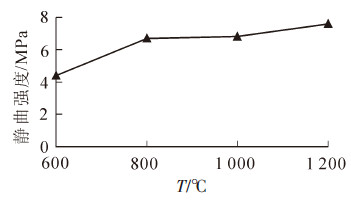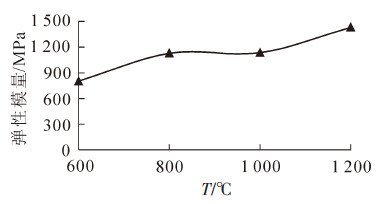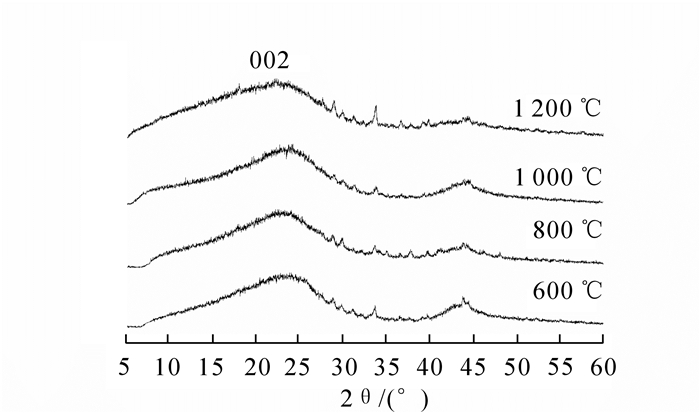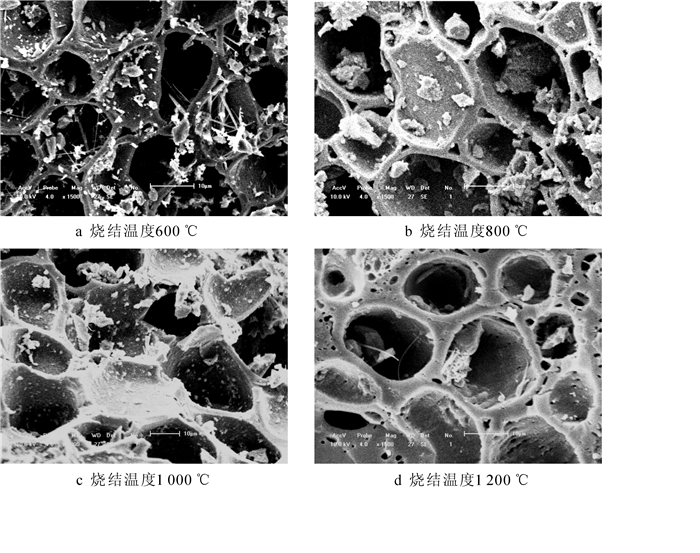-
木材陶瓷是由日本青森工业试验场的冈部敏弘和斋藤幸司采用木材或其他木质材料,在热固性树脂中浸渍后真空炭化而成的一种新型碳素材料[1-2]。木材陶瓷作为一种新型生物质陶瓷材料,具有多孔、导电、自润滑等特性,在摩擦、过滤、吸附、电磁屏蔽、房暖等领域有广阔的应用前景[3]。近年来,以木材为原料制备木材陶瓷的研究颇多且比较深入,而以竹材原料研制竹材陶瓷的报道较少。但中国木材资源较贫乏,而竹林面积、竹材产量却居世界之首[4]。故以竹材为原料研制竹材陶瓷,对于节约木材资源、保护生态环境等具有十分重要的意义。虽然中国竹材加工利用水平居世界领先地位,是大量的竹材加工剩余物——竹碎料,除部分用作锅炉辅助燃料、烧制竹炭等以外,多数没能开发利用,资源浪费较严重。若用竹碎料制造竹材陶瓷,就为其加工利用提供了新的途径。目前,有少数学者以竹粉、竹片、竹炭等为原料,进行了竹材陶瓷制造工艺、性能等研究[5-9],但未见以竹碎料为原料研制竹材陶瓷的报道。因此,本研究在前期研究的基础上[10],以竹地板生产中竹片精刨加工的剩余物-精刨竹碎料为原料研制竹材陶瓷,主要探讨烧结工艺对竹材陶瓷性能和结构等的影响规律,可为竹碎料的高效加工利用提供理论参考。
-
精刨竹碎料:竹地板生产中竹片精刨加工的剩余物,经筛选去除粉尘、泥砂、过大竹碎料后,干燥到含水率4%~6%。胶黏剂:水溶性酚醛树脂胶,固体含量为48%。
-
按酚醛树脂施加量40%对精刨竹碎料进行拌胶,经铺装、热压后制得密度为0.88 g·cm-3的竹碎料板,将它锯割成100 mm × 50 mm × 12 mm的试样。参照现有国内外文献中有关木竹材陶瓷的烧结工艺,根据竹碎料板的特点进行初步试验后,确定了如下烧结工艺:将试样放入管式电阻炉中,在氮气保护下,分别在600,800,1 000和1 200 ℃的烧结温度下烧制竹材陶瓷;烧结时的程序控制工艺为:先以5 ℃·min-1的升温速度升到150 ℃,保温20 min;之后以3 ℃·min-1的升温速度升到600 ℃(800,1 000,1 200 ℃),再保温烧结炭化3 h,然后以5 ℃·min-1的速度降温到200 ℃,最后随炉冷却,制得竹材陶瓷。
-
分别检测在600,800,1 000和1 200 ℃烧结温度下制得的竹材陶瓷的尺寸收缩率、密度减少率、炭得率、静曲强度和弹性模量,研究烧结工艺对竹材陶瓷性能的影响。其中,尺寸收缩率按照试件烧结前后的尺寸之差与烧结前尺寸的百分比计算,密度减少率按照试件烧结前后的密度之差与烧结前密度的百分比计算,炭得率按试件烧结后的质量与烧结前的质量的百分比计算,静曲强度和弹性模量采用三点弯曲方法在微机控制的万能力学试验机上测试。
-
采用日本岛津公司的XRD6000型X射线粉末衍射仪,分析不同烧结温度下竹材陶瓷的物相组成。X光管为铜靶,管电压为40 kV,管电流为30 mA,采用2θ/θ联动扫描,样品扫描范围5°~60°(2θ)。
-
采用日本岛津公司的SS-550型扫描电子显微镜(SEM),观察竹材陶瓷的微观结构。
-
由图 1可知:烧结温度不同竹材陶瓷的尺寸收缩率不同。当烧结温度为600~800 ℃时,竹材陶瓷的尺寸收缩率随着烧结温度的升高而较快增加;当烧结温度为800~1 000 ℃时,竹材陶瓷的尺寸收缩率大小接近、曲线变化趋于平稳;当烧结温度超过1 000 ℃时,竹材陶瓷尺寸收缩率的变化速度趋缓。其中,竹材陶瓷的长度收缩率、宽度收缩率随着烧结温度的升高而增大,而厚度收缩率在烧结温度600~1 000 ℃范围内随着烧结温度的升高而增加,当烧结温度超过1 000 ℃时却随着烧结温度的升高而降低;厚度收缩率大于长度收缩率和宽度收缩率,长度收缩率和宽度收缩率大小接近。图 1显示:不论哪种烧结温度下竹材陶瓷的尺寸收缩率都超过20%。可见,竹材陶瓷制备时的烧结温度对其尺寸收缩率有较大影响。这主要是因为在密封高温条件下烧结,竹碎料和酚醛树脂均发生了系列热分解,致使竹材陶瓷在长度、宽度和厚度方向的尺寸减小较多;然而,竹材陶瓷的尺寸收缩率在烧结温度800~1 000 ℃范围内却趋于平稳。因此,可认为竹材陶瓷的较佳烧结温度范围为800~1 000 ℃。
-
从图 2可得知:烧结温度在600~1 000 ℃范围内,竹材陶瓷的密度减少率随着烧结温度的升高而逐渐降低,其中烧结温度为600~800 ℃的密度减少率的变化速度较快,800~1 000 ℃的密度减少率大小接近、曲线变化较平稳;烧结温度超过1 000 ℃时密度减少率又随着烧结温度的升高而缓慢增加。究其主要原因可能是:竹材陶瓷的质量损失、体积收缩率都随着烧结温度的升高而逐渐增大,其中烧结温度为600~800 ℃时增加较快,大于1 000 ℃时增加趋缓,800~1 000 ℃时变化较平稳;而在相同烧结温度下质量损失率变化速度却快于体积收缩率。由图 3显示:随着烧结温度的升高竹材陶瓷的炭得率逐渐降低,其中烧结温度在600~800 ℃范围内的炭得率随着温度的升高较快降低,超过800 ℃时的炭得率降低速度趋缓,1 000℃的炭得率为800 ℃时的98.4%,而1 200 ℃时的炭得率为1 000 ℃时的97.4%。可见,当烧结温度大于800 ℃时,烧结温度对炭得率的影响就不大了。由于竹材陶瓷由竹碎料与酚醛树脂复合制得,故竹碎料板在高温炭化过程中的热解实际上由竹碎料的热解与酚醛树脂的热解共同组成。竹材与木材一样,其主要化学成分纤维素、半纤维素和木质素总的含量达90%以上,因而可以认为竹碎料的热解规律与木粉基本相同。而导致图 3所示炭得率的变化规律的主要原因是:在氮气保护下,竹碎料在240~400 ℃范围内热解最激烈,在800 ℃之前基本分解完全;而酚醛树脂在500~600 ℃范围内热解最激烈,在800 ℃之后热解才结束[11-12],而竹材陶瓷中竹碎料的量却大于酚醛树脂。因而烧结温度800 ℃前炭得率降低速度较快,之后降低速度变慢。
-
不同烧结温度制造的竹材陶瓷的静曲强度和弹性模量,分别见图 4和图 5。从图 4和图 5可以看出:随着烧结温度的升高,竹材陶瓷的静曲强度和弹性模量逐渐增加,但它们均不高。其中,烧结温度为600 ℃时的静曲强度和弹性模量最低,烧结温度1 200 ℃时的炭得率的静曲强度和弹性模量最高;烧结温度800 ℃和1 000 ℃制备的竹材陶瓷的静曲强度和弹性模量大小接近,曲线变化较平稳。这是因为在炭化过程中,碳的芳环结构形成始于400~500 ℃,随着炭化温度的升高,碳多环结构中碳原子数增多,石墨微晶长大且排列更加规则;特别是酚醛树脂生成的玻璃碳和竹碎料生成的无定形碳在高温度下会生长在一起,其界面逐渐消失,2种碳之间的结合强度增加[11],从而导致竹碎料板竹材陶瓷的静曲强度和弹性模量增加。此外,竹碎料板高温烧结成竹材陶瓷后,4种烧结温度所制竹材陶瓷的平均密度为0.67 g·cm-3,仅有烧结前密度0.88 g·cm-3的76.1%,加之竹材陶瓷中存在大量力学强度较低的无定形碳。因此,竹材陶瓷的静曲强度和弹性模量均不高。
-
从图 6竹材陶瓷的X射线衍射(XRD)图谱可知:竹材陶瓷的衍射峰都是宽峰,说明竹材陶瓷没有出现完整的晶形结构,是一种典型的无定形碳。因为竹碎料板高温烧结炭化后,竹碎料转化为软质无定型碳,而酚醛树转化为硬质玻璃碳,两者本质上都属于碳的无定形结构,是不具有石墨结构的非结晶性物质[13-14]。因而在烧结温度600~1 200 ℃范围内制得的竹材陶瓷并非是完全石墨化的碳,而是部分石墨化的无定型碳。图 6显示:随着烧结温度的升高,(002)衍射峰逐渐变窄变强,这表明竹材陶瓷中石墨微晶的含量增加,微晶中层与层之间的排列更趋于规整[15],且微晶的含碳量增加。因而随炭化温度的升高竹材陶瓷的石墨化程度逐渐增强。对比600,800,1 000和1 200 ℃烧结温度的XRD曲线可知,曲线的变化规律基本相同,只有强度差异,说明在烧结温度600~1 200 ℃内制得的竹材陶瓷的晶体构造基本相同,但结晶度发生了变化。
-
由不同烧结温度制造的竹材陶瓷的扫描电子显微镜(SEM)照片(图 7)可知:在不同烧结温度下制备的竹材陶瓷基本保持了竹材原有的微观结构形态,竹材陶瓷中竹材的薄壁细胞、导管等的微观结构形态依然清晰可见。但竹材细胞断面的孔隙部分或全部被须状、颗粒状、片状、层状等不同形态的物质中所填充、覆盖。这些填充、覆盖物质可能大部分是酚醛树脂经高温炭化后转化成的硬质玻璃碳。这是因为竹碎料板是由酚醛树脂胶黏剂与精刨竹碎料经过拌胶、铺装、热压等工序制得,在拌胶过程中液状的酚醛树脂胶黏剂分布于竹碎料之间,有的甚至渗透到竹材细胞腔及细胞间隙中,同时在热压过程中酚醛树脂胶黏剂进一步流展、渗透,待其固化后就留于竹材细胞腔及细胞间隙中,经高温炭化后酚醛树脂就转化成硬质玻璃碳,在微观上表现为填充、覆盖于竹材细胞的孔隙中,从而强化竹材细胞。从图 7还知:随着烧结温度的升高,竹材细胞中须状、颗粒状物质越少,而片状、层状物质却越多,竹材细胞的孔隙被填充、覆盖也越多,而且竹材细胞的微观结构形态也不断变化,细胞之间的分界逐渐变得模糊有的甚至消失。这进一步证实了随着烧结温度的升高,竹材陶瓷中石墨微晶的含量增加,微晶的含碳量增加,微晶中层与层之间的排列更趋于规整有序。
-
①烧结温度对竹材陶瓷的尺寸收缩率有较大影响。竹材陶瓷的尺寸收缩率随着烧结温度的变化而变化,其中厚度收缩率大于长度收缩率和宽度收缩率,长度收缩率和宽度收缩率大小接近。②烧结工艺对竹材陶瓷的密度减少率、炭得率、静曲强度和弹性模量均有影响。密度减少率在600~1 000 ℃范围内随着烧结温度的升高逐渐降低,烧结温度超过1 000 ℃后却逐渐增加;竹材陶瓷的炭得率随着烧结温度的升高逐渐降低,而静曲强度和弹性模量却随着烧结温度的升高逐渐增加。③竹材陶瓷是一种典型的无定形碳。随着烧结温度的升高,竹材陶瓷的石墨化程度逐渐增强。④存在于竹材细胞之间、细胞腔及细胞间隙中的酚醛树脂,经高温炭化后形成的硬质玻璃碳对竹材细胞有填充、强化作用。⑤烧结温度为800~1 000 ℃时,可制得尺寸收缩率、炭得率、力学强度等性能较稳定的竹材陶瓷。
Sintering technology of bambooceramics prepared from bamboo particles with phenol-formaldehyde resin
-
摘要: 以精刨竹碎料和酚醛树脂为原料,采用高温真空炭化烧结工艺制备了竹材陶瓷,研究了烧结工艺对竹材陶瓷性能、物相组成和微观结构等的影响。结果表明:①烧结温度对竹材陶瓷的尺寸收缩率有较大影响,当烧结温度为600~1 200 ℃时,竹材陶瓷的尺寸收缩率大于20%范围内;②竹材陶瓷的密度减少率在600~1 000 ℃范围内,随着烧结温度的升高逐渐降低,在1 000~1 200 ℃范围内,随着烧结温度的升高逐渐增加;③随着烧结温度的升高,竹材陶瓷的炭得率降低、静曲强度和弹性模量升高、石墨化程度逐渐增强;④酚醛树脂经高温炭化后形成的硬质玻璃碳对竹材细胞起填充、强化作用;⑤竹材陶瓷的较佳烧结温度范围为800~1 000 ℃。图7参15Abstract: To determine the effects of sintering technology on microstructure, phase identification, and properties of bambooceramics, a new bambooceramics was prepared by carbonizing in a vacuum at high temperatures using phenol-formaldehyde resin and precision-shaved bamboo particles as raw materials. Results showed that (1) sintering temperatures had a strong influence on the dimension shrinkage ratio of the bambooceramic and was greater than 20% when the sintering temperature was 600-1 200 ℃. Also, (2) the density reduction ratio of bambooceramics gradually decreased with an increase in the sintering temperature from 600 ℃ to 1 000 ℃, then gradually increased from 1 000 ℃ to 1 200 ℃. Next, (3) with an increase in sintering temperature, the carbon yield ratio of bambooceramics decreased, its modulus of rupture (MOR) and modulus of elasticity (MOE) increased, and its degree of graphitization gradually increased. Finally, (4) the hard glass carbon from phenol resin formed by high temperature carbonization filled and reinforced the bamboo cell, thereby improving (5) the sintering temperature range of bambooceramics to 800-1 000 ℃.[Ch, 7 fig. 15 ref.]
-
城市绿地对改善城市生态环境恶化等问题具有举足轻重的作用[1]。目前,对城市绿地生态效益的研究因受生态系统服务功能多样、区域环境及人类社会活动需求差异等因素影响,呈现出评估方法众多但评价内容、指标及结果差异性大等问题[2-3]。随着大数据等现代技术的应用,城市绿地生态效益价值的评估已经由原来的传统方法逐渐发展到计算机模型测算法[4-5]。由美国林务局2006年开发的i-Tree模型因树种匹配灵活、分析结果精确、评估对象尺度多元等优点,自推出至今在国际上尤其是北美国家已得到了大量的应用[6]。近年来中国合肥[7]、杭州[8]、南京[9]等地已有大量基于该模型的生态效益研究成果,但呈现出以研究城市森林等大区域尺度及城市社区行道树等小微尺度为主的特征,仅有魏云龙[10]、施炜婷等[11]、施健健等[5]对城市公园、广场这类中小尺度的绿地进行评估,且仅以研究单种生态效益功能或植物个体生态效益为主。本研究以临安吴越钱王陵公园为研究对象,运用i-Tree模型对公园植物群落结构及节能、改善空气质量、吸收二氧化碳(CO2)、截留雨水等4个方面的生态效益价值进行定量评估,以期为钱王陵公园及当代城市公园植物群落提升建设过程中群落及树种选择提供一定参考,丰富该模型在城市绿地生态效益研究的理论与内容。
1. 研究地区与研究方法
1.1 研究地概况
临安区位于杭州市西部,29°56'~30°23'N,118°51'~119°52'E,属亚热带季风气候,年平均降水量1 613.90 mm,降水日158.0 d,全年平均气温16.4 ℃,全年日照时数1 847.3 h。钱王陵公园坐落在临安区锦城太庙山南坡,2018年作为杭州地区唯一代表入选浙江省级考古遗址公园,在塑造城市形象、传承历史文化、市民公共游憩活动等方面起重要作用;该园建成至今已有20余a,占地10.30 hm2,海拔92.0 m[12]。园内植物生长稳定,群落结构水平和垂直结构差异明显,群落景观多样,类型丰富。
1.2 调查内容与方法
本研究调查对象为钱王陵公园内的典型人工植物群落。在对公园全面勘查的基础上,于2019年8−9月采用典型取样法,设置32个20 m×20 m,面积为400 m2的典型样地,按照L1至L32顺序对样地编号(表1);采用每木测量法,对样地内的植物种类、数量、胸径、树高、冠幅、健康状况以及立地条件、水体、道路、铺装广场的占比状况进行调查[5],后期整理汇总。
表 1 钱王陵公园植物群落基本类型Table 1 Basic types of plant communities in Qianwangling Park群落类型 垂直结构类型 样地编号(群落名称) 针阔混交型 乔-灌-草 L1(水杉Metasequoia glyptostroboides+樟树群落)、L2(圆柏Sabina chinensis+樟树群落)、L3(雪松 Cedrus deodara+樟树群落)、L4(塔柏Sabina chinensis ‘Pyramidalis’+圆柏+樟树群落)、L5(塔 柏+樟树群落)、L6(塔柏+樟树+棕榈Trachycarpus fortunei群落)、L9(桂花Osmanthus fragrans+水 杉群落)、L11(水杉+柳杉Cryptomeria fortunei+樟树群落)、L14(水杉+枫香Liquidambar formosana群落)、L18(樟树+罗汉松Podocarpus macrophyllus群落) 乔-灌 L7(水杉+广玉兰群落Magnolia grandiflora)、L17(马尾松Pinus massoniana+深山含笑Michelia maudiae群落) 乔-草 L25(马尾松+樟树群落) 常绿阔叶型 乔-灌-草 L8(桂花群落)、L13(樟树+广玉兰+桂花群落)、L16(樟树+广玉兰群落)、L21(樟树+广玉兰-山茶 Camellia japonical群落)、L26(樟树+桂花群落)、L30(樟树+女贞Ligustrum lucidum+桂花群落) 乔-草 L23(樟树+女贞群落)、L28(樟树+棕榈群落) 常绿落叶阔叶混交型 乔-灌-草 L10(樟树+山樱花Prunus serrulata群落)、L15(樟树+银杏Ginkgo biloba群落)、L26(樟树+枫香+ 构树Broussonetia papyrifera群落(L20) 乔-草 L19(樟树+枫香+油茶Camellia oleifera群落)、L22(樟树+枫香+棕榈群落)、L24(樟树+枫香群落)、 L27(樟树+栓皮栎Quercus variabilis群落) 乔-灌 L12(樟树+榔榆Ulmus parvifolia群落) 竹阔混交型 乔-灌-草 L29(毛竹Phyllostachys edulis+枫香群落)、L32(毛竹+樟树-山茶群落)、L31(毛竹+樟树群落) 1.3 i-Tree模型生态效益评估原理
评估采用i-Tree V5.0版本的streets模块。将模型内测算树木节能效益的电费和天然气经济指标价格修正为2018年临安区居民生活用电的平均价格0.59元·kW−1·h−1和天然气平均价格3.66元·m−3;碳吸收、改善空气质量、截留雨水效益的计算参照魏云龙[10]基于该模型同一模块对花港观鱼公园生态效益测算价格指标,用于导入及输出的美元效益价值量采用2019年8月及9月美元对人民币平均汇率(1美元兑换7.04元人民币)进行换算[13]。基于临安亚热带季风气候条件及杭州地区该模型相关研究[5, 10],匹配沿海平面(coastal plain)气候区作为背景开展评估,对树种数据库中没有的树种依据其属性进行同属或同叶型的树种匹配,最后将整理好的树种实测数据整理成Access数据库,并处理成mdb格式文件导入模型中开展评估。
2. 结果与分析
2.1 群落类型及空间结构分析
参照《中国植被》[14]、尚玉昌[15]生态学优势种命名法、武文婷[16]对于杭州城市绿地植被类型划分原则,以植物群落本身特征作为划分依据,以生态外貌为高级分类单位,中低级单位采用优势种(以重要值为依据),对所调查植物群落进行划分得出(表1):竹阔混交型群落占比为9.37%,常绿落叶阔叶混交型和常绿阔叶型群落占比同为25.00%,针阔混交型群落占比最高(40.63%);公园整体表现出以针阔混交型群落为主的植物景观风貌,营造出纪念性公园四季常青、庄严肃穆的景观氛围。
根据水平结构上的配置模式,将群落划分为纯林和混交林2种类型[17]。在水平结构上,混交林占比为93.75%,呈现出主导地位;在垂直结构上,“乔-灌-草”型复层模式群落占68.75%;双层模式群落只出现“乔-草”及“乔-灌”这2种类型,分别占21.88%和9.37%。复层型为公园植物群落的主要构建模式。
2.2 植物群落树种结构分析
参照《浙江植物志》等[18-19],对所调查32个植物群落树种分析可知:调查植物共计113种,分属于63科98属。符合测量评估条件的乔、灌木共1 613株,隶属于39科62属74种。i-Tree模型内置的“Define Species”功能将树木分为常绿阔叶树种(BE)、落叶阔叶树种(BD)、常绿针叶树种(CE)、落叶针叶树种(CD)、常绿棕榈树种(PE)5种生长类型,且每一类型又分为大(L)、中(M)、小(S)3类[10]。由图1可知:公园内常绿树占比约是落叶树占比的4倍,群落总体表现出以常绿树为主的林相,季相变化不够丰富;公园内阔叶树种占79.11%,针叶树种占12.46%,阔叶树约为针叶树6倍,针叶树种数量偏少,不符合纪念性公园以针叶树偏多的特点。
从数量上来看,株数排名前10位的树种分别是:樟树(22.13%)、毛竹(10.17%)、桂花(9.92%)、棕榈(8.43%)、枫香(6.01%)、山茶(4.03%)、圆柏(3.72%)、广玉兰(2.60%)、罗汉松(2.60%)、女贞(2.17%);这10个树种数量占调查总数的71.79%;但仅有樟树、桂花、棕榈这3种乡土树种应用频度在50%以上,构成整个公园的优势树种。总体来看,钱王陵公园树种丰富,但绝大多数乔、灌木应用频度低、景观单调。
从胸径结构来看,i-Tree模型主要将树种胸径划分为7个等级。由图2可知所调查群落树种胸径主要集分布在≤45.7 cm,胸径在45.70~61.00 cm的占比1.55%,胸径在61.00~76.20 cm和76.20~94.10 cm的占比都为0.06%。公园内树种胸径呈现以中小径级为主,且随着胸径增大树种数量显著减少现象。
2.3 群落生态效益分析
树木通过遮光、降低风速、叶片蒸腾散热等方式,起到改善小气候、节约能源的作用[20];光合、呼吸等作用吸收CO2和水转化为有机物并释放氧气,实现碳氧循环减缓温室效应[21];通过树冠、树叶、树皮表面对雨水进行拦截,延缓暴雨峰值,起到减少雨水径流的效果[22]。运用i-Tree模型对钱王陵公园32个植物群落节约能源、截留雨水、吸收CO2和改善空气质量生态效益价值定量评估得出(表2):4类生态效益年总价值为208 588.16元·a−1,平均单株生态效益为129.25元·株−1·a−1。对生态效益价值贡献最大的是吸收CO2,占47.20%;节约能源效益与截留雨水效益价值相近,分别占23.10%和27.77%;改善空气质量效益最低,仅占1.93%。这4类生态效益按照价值量从高到低排名依次为吸收CO2、截留雨水、节约能源、改善空气质量。生态效益最高的是樟树+广玉兰-山茶群落(L21),为12 777.60元·a−1,占6.13%;最低的是樟树+银杏群落(L15),为1 203.84元·a−1,仅占0.58%。不同类型群落生态效益价值存在较大差距,对生态效益贡献最大的为针阔混交型群落,总生态效益占比为35.47%;其次是常绿阔叶型群落,占比为27.61%;常绿落叶阔叶混交型群落占比为26.17%;竹阔混交型最少,仅占10.75%。
表 2 钱王陵公园32个植物群落总生态效益Table 2 Total ecological benefits of 32 plant communities in Qianwangling Park群落 生态效益/(元·a−1) 效益
占比/
%群落 生态效益/(元·a−1) 效益
占比/
%节约
能源吸收
CO2改善空
气质量截留
雨水总生态
效益节约
能源吸收
CO2改善空
气质量截留
雨水总生态
效益L1 1 070.08 2 168.32 98.56 1 351.68 4 688.64 2.25 L18 1 830.40 3 365.12 28.16 2 400.64 7 624.32 3.66 L2 1 520.64 3 182.08 183.04 1 879.68 6 765.44 3.24 L19 1 457.28 2 872.32 49.28 1 696.64 6 075.52 2.91 L3 1 267.20 2 696.32 133.76 1 591.04 5 688.32 2.73 L20 1 584.00 2 977.92 112.64 1 809.28 6 483.84 3.11 L4 1 112.32 2 393.60 91.52 1 337.60 4 935.04 2.37 L21 2 851.20 5 850.24 232.32 3 843.84 12 777.60 6.13 L5 781.44 1 605.12 42.24 851.84 3 280.64 1.57 L22 2 175.36 4 238.08 126.72 2 745.60 9 285.76 4.45 L6 1 041.92 2 154.24 112.64 1 203.84 4 512.64 2.16 L23 1 802.24 3 808.64 161.92 2 259.84 8 032.64 3.85 L7 1 415.04 3 196.16 154.88 1 675.52 6 441.60 3.09 L24 2 245.76 4 540.80 112.64 2 520.32 9 419.52 4.52 L8 711.04 1 921.92 126.72 682.88 3 442.56 1.65 L25 1 457.28 2 949.76 112.64 1 619.20 6 138.88 2.94 L9 1 619.20 4 026.88 168.96 1 900.80 7 715.84 3.70 L26 1 760.00 3 597.44 161.92 2 316.16 7 835.52 3.76 L10 1 344.64 3 238.40 168.96 1 415.04 6 167.04 2.96 L27 2 696.32 5 005.44 253.44 3 182.08 11 137.28 5.34 L11 1 422.08 3 048.32 35.20 1 774.08 6 279.68 3.01 L28 2 041.60 4 055.04 140.80 2 907.52 9 144.96 4.38 L12 1 119.36 2 358.40 126.72 1 217.92 4 822.40 2.31 L29 1 809.28 3 013.12 197.12 1 752.96 6 772.48 3.25 L13 675.84 1 492.48 77.44 830.72 3 076.48 1.47 L30 1 506.56 3 104.64 84.48 1 844.48 6 540.16 3.14 L14 732.16 1 555.84 84.48 725.12 3 097.60 1.49 L31 1 774.08 3 372.16 133.76 2 337.28 7 617.28 3.65 L15 260.48 577.28 28.16 337.92 1 203.84 0.58 L32 2 062.72 3 548.16 239.36 2 189.44 8 039.68 3.85 L16 1 520.64 3 160.96 147.84 1 907.84 6 737.28 3.23 总计 48 188.80 98 447.36 4 019.84 57 932.16 208 588.16 100 L17 1 520.64 3 358.08 98.56 1 837.44 6 814.72 3.27 对群落各生态效益分析可知:i-Tree模型对节能效益的评估由节约电量和节约天然气效益两部分组成,其中节约电量为62 227.20 kW·h·a−1,产生生态效益为36 706.56元·a−1;节约天然气量3 560.50 m³·a−1,产生生态效益11 482.24元·a−1,节约能源的生态效益总价值为48 188.80元·a−1,单株树木平均生态效益为29.85元·株−1·a−1;节能效益最高的是樟树+广玉兰-山茶群落(L21),为2 851.20元·a−1;最低的是樟树+银杏群落(L15),为260.48元·a−1;从群落类型来看,节能效益总量占比最高的是针阔混交型群落,为34.84%,该类群落在节能效益价值方面优势较高。经模型计算植物群落吸收CO2总量为81 951.00 kg·a−1,产生生态效益价值98 447.36元·a−1,单株平均吸收CO2生态效益为61.04元·株−1·a−1;对不同类型群落生态效益分析可知:针阔混交型群落生态效益占比最高,为36.26%,在吸收CO2方面表现出一定优势。模型计算群落年截留雨水量为5 192.00 m³·a−1,产生生态效益为57 932.16元·a−1,单株树木平均截留雨水生态效益为35.90元·株−1·a−1。对单株树木平均截留雨水生态效益分析可以得出,针阔混交型群落中树木平均效益超过总平均生态效益的群落数量最多且效益排名靠前,说明相对其他类型该群落类型在截留雨水上具有优势。模型计算植物群落年改善空气质量生态效益为4 019.84元·a−1,单株树木平均生态效益为2.46元·株−1·a−1,明显低于以上3个功能,其中群落间接减排空气污染物[二氧化氮(NO2)、可吸入颗粒物(PM10)、挥发性有机化合物(VOC)、二氧化硫(SO2)]生态效益最高,为6 188.16元·a−1,SO2减排量最高为220.40 kg·a−1,占66.85%;群落吸附沉积空气污染物[NO2、臭氧(O3)、PM10和SO2]效益为2 731.52元·a−1,对O3的沉积效果最强,占比为58.65%;SO2的沉积效果最差仅6.14%。此外,树木自身代谢等作用会散发挥发性有机物污染(BVOCs)对空气造成污染[23],经计算该公园群落释放BVOCs量为213.20 kg·a−1,产生生态效益−4 899.84 元·a−1,其中樟树+广玉兰-山茶群落(L21)释放量最多,为13.30 kg·a−1;从改善空气质量综合能力来看,樟树+栓皮栎群落(L27)效果最强,产生生态效益最高,为253.44元·a−1,占6.30%,同时间接减排空气污染物的能力也最为显著。综合看来,树木在间接减排空气污染物方面上更具优势。
对群落树种单株平均生态效益分析可知,排名前10位树种为落叶阔叶树和针叶树(表3),针叶树有水杉、雪松、马尾松,其余的为落叶阔叶树。常绿阔叶树种未出现,生态效益偏低。综合树种平均胸径及各生态效益分析可知,在平均胸径相近情况下,落叶阔叶树各项生态效益高于针叶树,即落叶阔叶树在节能、吸收CO2、改善空气质量及截留雨水方面都表现出更高优势。单株平均生态效益价值由高到低排名前10位的树种为三角枫Acer buergerianum、黄山栾树Koelreuteria paniculata、水杉、栓皮栎、雪松、马尾松、山樱花、朴树Celtis bungeana、榔榆、垂柳Salix babylonica,在植物群落构建时对于落叶阔叶树和针叶树树种的选择可优先考虑。
表 3 单株平均效益前10位树种各生态效益Table 3 Per plant benefit,top ten tree species, ecological benefits效益排名 树种名称 生长类型 单株生态效益/(元·株−1·a−1) 单株平均生态效益/
(元·株−1·a−1)平均胸径/cm 节约能源 吸收CO2 改善空气质量 截留雨水 1 三角枫 BDM(落叶阔叶中型树) 119.82 300.40 18.66 119.33 558.21 35.04 2 黄山栾树 BDM(落叶阔叶中型树) 97.72 213.73 16.12 100.95 428.52 30.26 3 水杉 CDL(落叶针叶大型树) 95.46 203.03 −1.76 119.47 416.20 41.47 4 栓皮栎 BDL(落叶阔叶大型树) 79.20 177.76 12.88 76.03 345.87 37.05 5 雪松 CEL(常绿针叶大型树) 76.88 163.40 2.60 82.09 324.97 30.33 6 马尾松 CEL(常绿针叶大型树) 75.82 161.36 1.55 84.83 323.56 33.65 7 山樱花 BDM(落叶阔叶中型树) 69.98 161.43 11.26 66.81 309.48 26.50 8 朴树 BDL(落叶阔叶大型树) 79.62 130.17 13.38 78.14 301.31 27.44 9 榔榆 BDM(落叶阔叶中型树) 63.15 148.54 10.14 60.19 282.02 24.48 10 垂柳 BDM(落叶阔叶中型树) 49.63 122.78 7.88 46.96 227.25 26.48 结合表3和表4分析可知:L21群落(樟树+广玉兰-山茶群落)树种株数占比不高(排第10位),但群落平均胸径最高,单株生态效益高的落叶阔叶树种三角枫、栓皮栎和针叶树马尾松平均胸径都较高。而L22群落(樟树+枫香+棕榈群落)树种株数占比较低,但群落平均胸径高,因此生态效益也相对较高。L24群落(樟树+枫香群落)、L27群落(樟树+栓皮栎群落)和L28群落(樟树+棕榈群落)树种株数占比相似(分别为4.4%、4.0%和4.3%),而群落L27和群落L28相比,群落整体平均胸径相近,但群落L27中单株生态效益高的树木数量及平均胸径更具有优势,因此该群落效益更高;L24群落平均胸径偏低,但单株平均效益高树种株株多,因此生态效益也较高。在树种生长型方面,胸径>30 cm的落叶阔叶和针叶高生态效益树种株数占比越高对生态效益贡献越大。综上分析,群落生态效益的高低主要取决于树种的株数、生长类型和平均胸径。从构建高生态效益植物群落角度出发,建议植物群落构建时以三角枫、黄山栾树、水杉、栓皮栎、雪松、马尾松等高单株生态效益的树木为优势种,以提高植物群落整体生态效益。
表 4 生态效益排名前5位群落指标分析Table 4 Analysis of the top five community indicators in benefit ranking排名 样地
编号群落
类型主要组
成树种单株生态效益排名前10树种
(株数及平均胸径)群落整体平均
胸径/(cm·株−1)群落树种株数
占比/%(排名)1 L21 常绿阔叶型 樟树+广玉兰+棕榈-山茶 三角枫(4株,胸径35.06 cm)、栓皮栎(1株,
胸径45.39 cm)、马尾松(2株,胸径39.33 cm)25.70 3.6(10) 2 L27 常绿落叶阔叶
混交型樟树+栓皮栎+女贞+棕榈+
黄山栾树+枫香黄山栾树(3株,胸径29.47 cm)、朴树(1株,
胸径32.16 cm)、栓皮栎(10株,胸径30.86 cm)20.56 4.0(5) 3 L24 常绿落叶阔叶
混交型枫香+樟树+棕榈 栓皮栎(3株,胸径16.73 cm)、马尾松(2株,
胸径36.22 cm)17.96 4.4(3) 4 L22 常绿落叶阔叶
混交型枫香+樟树+棕榈-山茶 马尾松(2株,胸径34.00 cm) 25.31 2.7(19) 5 L28 常绿阔叶型 樟树+女贞+棕榈 马尾松(1株,胸径42.61 cm)、三角枫(1株,
胸径34.98 cm)、雪松(1株,胸径28.83 cm)20.03 4.3(4) 3. 结论与讨论
本研究采用典型取样法及每木调查法对钱王陵公园32个植物群落内所有符合测量条件的乔、灌木进行实地调查。调查树木共计1 613株,分属39科62属74种。群落树种种类丰富,胸径结构分布合理,呈现出较明显上、中、下层分布。在水平结构上以混交型为主,垂直结构以复层模式为主,且表现出以针阔混交型群落为主的景观风貌。公园内存在常绿树、阔叶树数量占比远超落叶树、针叶树,树木生长类型分布不合理,多数灌木及草本植物生长状况不佳,林间凋落物堆积过厚等问题。这与公园建成时间久远缺乏管理与维护有关。从公园长远发展角度考虑,应基于该公园的纪念性特点,增加落叶树与松柏类针叶树种数和株数,营造庄重、肃穆的纪念氛围,以构建更加完善和稳定的植物群落结构体系。
钱王陵公园32个植物群落年总生态效益为208 588.16元·a−1,节约能源、吸收CO2、改善空气质量和截留雨水生态效益价值分别为48 188.80、98 447.36、4 019.84和57 932.16元·a−1,占比分别为23.10%、47.20%、1.93%和27.77%。这4类效益按照价值量高低排名为吸收CO2、截留雨水、节约能源、改善空气质量。结果与魏云龙[10]研究排名一致,其中吸收CO2生态效益最高,贡献最大。这与树种本身对CO2吸收能力较强有关。不同类型群落生态效益存在明显差异,针阔混交型群落总生态效益最高,占38.38%,表现出显著优势。这是由于该类型群落数量(占38.38%)及树种株数(占35.30%)最多,且水杉、马尾松、雪松等单株平均生态效益高的树种占比大。其次分别为常绿阔叶型、常绿落叶阔叶混交型和竹阔混交型群落;常绿阔叶型群落数量与常绿落叶阔叶混交型群落数量相同,占比为25%。常绿阔叶型群落总生态效益占比为27.61%,树种株数占24.1%;常绿落叶阔叶混交型群落总生态效益占比为26.71%及树种株数占26.20%。竹阔混交型群落在群落数量(占9.37%)及树种株数(占14.5%)上都为最少,导致生态效益占比最低为10.75%。
在城市绿地的建设过程中,i-Tree模型能从资源结构及生态效益方面对植物群落进行定量评估,将不同群落和树种的生态效益以货币形式更直观地展示出来,若将其引入城市绿地植物群落构建的“人工形成—自然进程—人工调控”的动态过程中,将使高生态效益绿地的建设更加具有科学性、高效性和便捷性。由于该模型是基于美国的生态环境而开发的,应用于本研究评估时在树种匹配上有一定的局限性,因此对于国内树种的研究以及完善更新模型基础数据库,使之能够更好地适用于本土树种,是今后重点研究方向。在生态服务功能评估上,由于i-Tree模型限制,只从节约能源、吸收CO2、改善空气质量、截留雨水等4个方面对钱王陵公园生态服务功能价值进行评估。植物群落生态服务功能的种类众多,还包括释放氧气、改良土壤及减少空气中负离子等,因此还需从深度和广度上加以进一步完善和提高。在成本参数上,模型中需要输入清除空气中O3、PM10和VOC等成本参数,因国内未有统一标准,参数获取难度大。在参照国内该模型的相关研究基础上,使用了模型的内置参数进行评估。在以后的研究中,应该建立符合国内情况的处理空气污染物和截留雨水相关参数指标,从而更加完善地运用评估模型对生态效益价值进行评估研究。
-
-
[1] HIROSE T, ZHAO Binyuan, OKABE T, et al. Effect of carbonization temperature on the basic properties of wood ceramics made from carbonized bamboo fiber and liquefied wood [J]. J Mater Sci, 2002, 37(16): 3453-3458. [2] 马荣, 乔冠军, 金志浩. 木材陶瓷[J]. 兵器材料科学与工程, 1998, 21(6): 45-48. MA Rong, QIAO Guanjun, JIN Zhihao. Woodceramics [J]. Ordnance Mater Sci Eng, 1998, 21(6): 45-48. [3] 乔冠军, 金志浩. 用木材制备生物结构陶瓷[J]. 材料导报, 2003, 17(4): 66-69. QIAO Guanjun, JIN Zhihao. Biostructure ceramics derived from wood [J]. Mater Rev, 2003, 17(4): 66-69. [4] 王凡非, 王文衡. 我国竹材人造板生产现状与问题初探[J]. 中国人造板, 2007, 14(12): 1-4. WANG Fanfei, WANG Wenheng. The status quo and problems of bamboo-based panels production in China [J]. China Wood-Based Panels, 2007, 14(12): 1-4. [5] 江泽慧, 任海青, 费本华, 等. 竹炭及SiC陶瓷材料的结构与性能[J]. 新型炭材料, 2006, 21(1): 1-8. JIANG Zehui, REN Haiqing, FEI Benhua, et al. Them icro-structure and properties of charcoal and SiC ceramics derived from bamboo [J]. New Carbon Mater, 2006, 21(1): 1-8. [6] 周蔚虹, 喻云水, 曹宏彰, 等. 竹粉/呋喃树脂制备木陶瓷的研究[J]. 硅酸盐通报, 2010, 29(6): 11380-1383, 1388. ZHOU Weihong, YU Yunshui, CAO Hongzhang, et al. Research on woodcernics prepared from bamboo powder-furane resin composite [J]. Bull Chin Ceram Soc, 2010, 29(6): 11380-1383, 1388. [7] 孙德林, 余先纯, 王荣, 等. 烧结温度对环氧树脂/竹基木陶瓷性能的影响[J]. 材料热处理学报, 2011, 32(9): 18-22. SUN Delin, YU Xianchun, WANC Rong, et al. Effects of sintering temperature on performance of epoxy resin/bamboo woodceramics [J]. Trans Mater Heat Treat, 2011, 32(9): 18-22. [8] 田根林, 余雁, 张求慧, 等. 竹基SiC/C生物陶瓷的制备和性能[J]. 林业科学, 2012, 48(1): 138-142. TIAN Genlin, YU Yang, ZHANG Qiuhui, et al. Fabrication and performance of bamboo-based SiC/C biological ceramics [J]. Sci Silv Sin, 2012, 48(1): 138-142. [9] 程大莉, 蒋身学. 不同密度的竹陶瓷的性能研究[J]. 林业科技开发, 2013, 27(2): 77-80. CHENG Dali, JIANG Shenxue. Properties of bamboo ceramics with different densities[J]. China For Sci Technol, 2013, 27(2): 77-80. [10] DU Chungui, LI Ren, ZHANG Weigang, et al. Study on bamboo particleboard bambooceramics-bamboo particletypes and resin content influence on properties of bamboo particleboard [J]. Appl Mech Mater, 2014, 584/586: 1461-1464. [11] 钱军民, 王继平, 金志浩. 由椴木木粉和酚醛树脂制备木材陶瓷的研究[J]. 无机材料学报, 2004, 19(2): 335-341. QIAN Junmin, WANG Jiping, JIN Zhihao. Woodceramics prepared from basswood powder and phenolic resin[J]. J Inorg Mater, 2004, 19(2): 335-341. [12] 陶毓博, 李淑君, 李鹏, 等. 酚醛树脂用量对木陶瓷性能的影响[J]. 材料热处理学报, 2010, 31(2): 26-29. TAO Yubo, LI Shujun, LI Peng, et al. Effect of phenolic resin proportion on properties of woodceramics [J]. Trans Mater Heat Treat, 2010, 31(2): 26-29. [13] 钱军民, 金志浩, 王继平. 酚醛树脂/木粉复合材料制备木材陶瓷结构变化过程研究[J]. 复合材料学报, 2004, 21(4): 18-23. QIAN Junmin, JIN Zhihao, WANG Jiping. Study on structural changes during preparing woodceramics from phenolic resin /basswood powder composite [J]. Acta Mater Compos Sin, 2004, 21(4): 18-23. [14] TZENG S S, CHR Y G. Evolution of microstructure and properties of phenolic resin-based carbon/carbon composites during pyrolysis [J]. Mater Chem Phys, 2002, 73(2/3): 162-169. [15] 涂建华, 张利波, 彭金辉, 等. 炭化温度对木质陶瓷性能和结构的影响[J]. 材料热处理学报, 2006, 27(3): 10-15, 21. TU Jianhua, ZHANG Libo, PENG Jinhui, et al. Effect of carbonization temperature on the properties and structure of woodceramics from carbonizing tobacco stems phenolic resin composites[J]. Trans Mater Heat Treat, 2006, 27(3): 10-15, 21. 期刊类型引用(7)
1. 余显显,武一帆,孔令鹏,赵玉西,王泳涵,杨眉佳,吴国玺. 基于i-Tree Eco模型的滨河景观生态效益分析——以许昌市饮马河北段为例. 国土与自然资源研究. 2025(02): 81-86 .  百度学术
百度学术2. 姚晓洁,杜存刚. 基于i-Tree模型的公园植物群落与生态效益研究——以蚌埠市张公山公园为例. 长春大学学报. 2025(02): 35-41 .  百度学术
百度学术3. 圣倩倩,周成宇,祝遵凌. 城市绿化生态功能评价研究进展——基于CiteSpace知识图谱分析. 江苏林业科技. 2023(01): 51-57 .  百度学术
百度学术4. 谢雪咏,张鲲,陈治儒,谭小昱,廖晨阳. 城市公园植物群落生态效益与游憩满意度评价——以成都市东湖公园为例. 建筑与文化. 2023(12): 233-236 .  百度学术
百度学术5. 刘小冬,陈海涛,罗立杰,潘晨. 城市公园乔木群落特征与多样性分析——以广州市为例. 现代园艺. 2022(19): 43-45 .  百度学术
百度学术6. 姚侠妹,偶春,夏璐,姚晓洁,陈媛媛,王宁馨. 安徽沿淮地区小城镇主要景观树种固碳释氧和降温增湿效益评估. 生态学杂志. 2021(05): 1293-1304 .  百度学术
百度学术7. 盛超群,蒋文伟. 秋季城市公园绿地小气候环境与人体舒适度实测研究. 现代农业研究. 2021(12): 93-94 .  百度学术
百度学术其他类型引用(7)
-

-
链接本文:
https://zlxb.zafu.edu.cn/article/doi/10.11833/j.issn.2095-0756.2016.03.014




 下载:
下载:
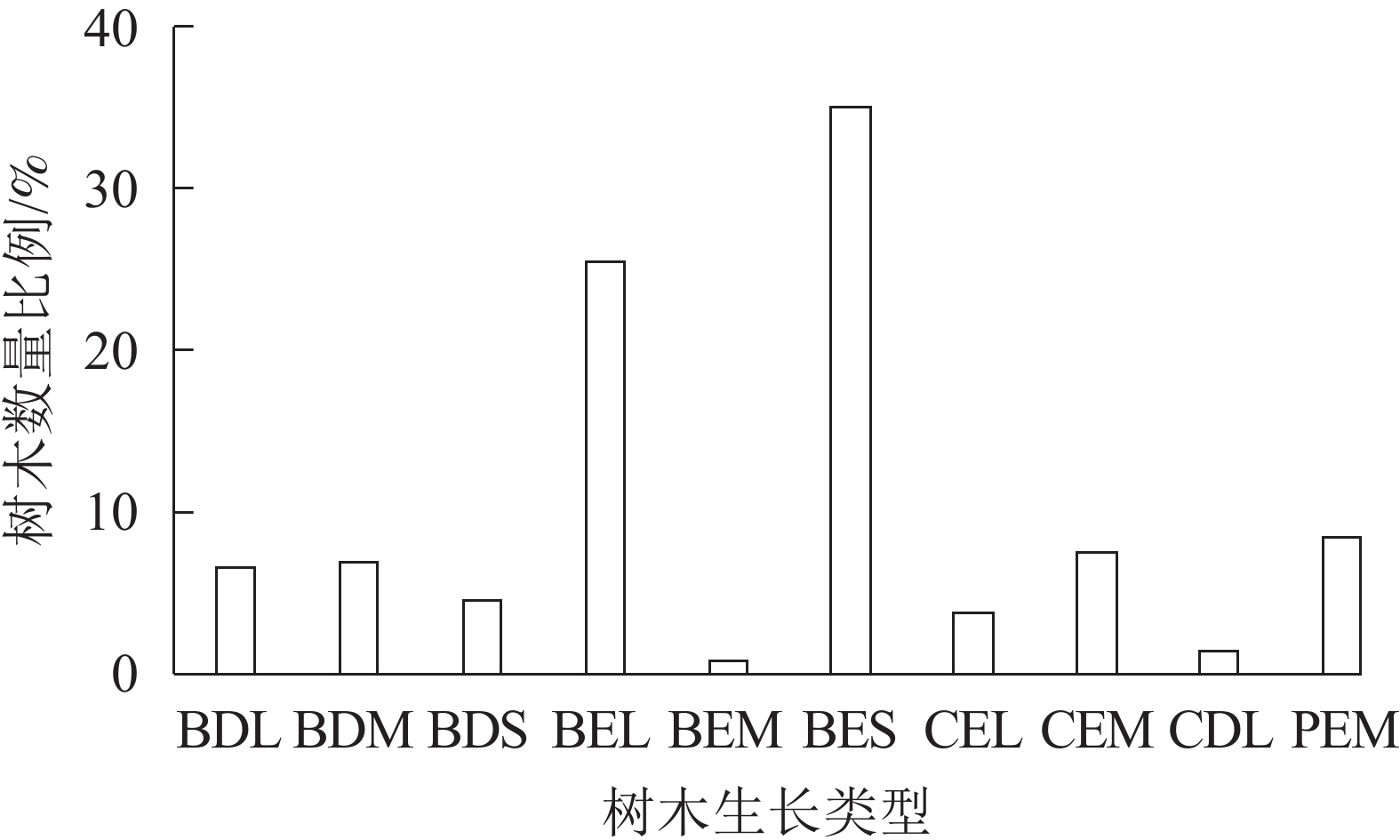
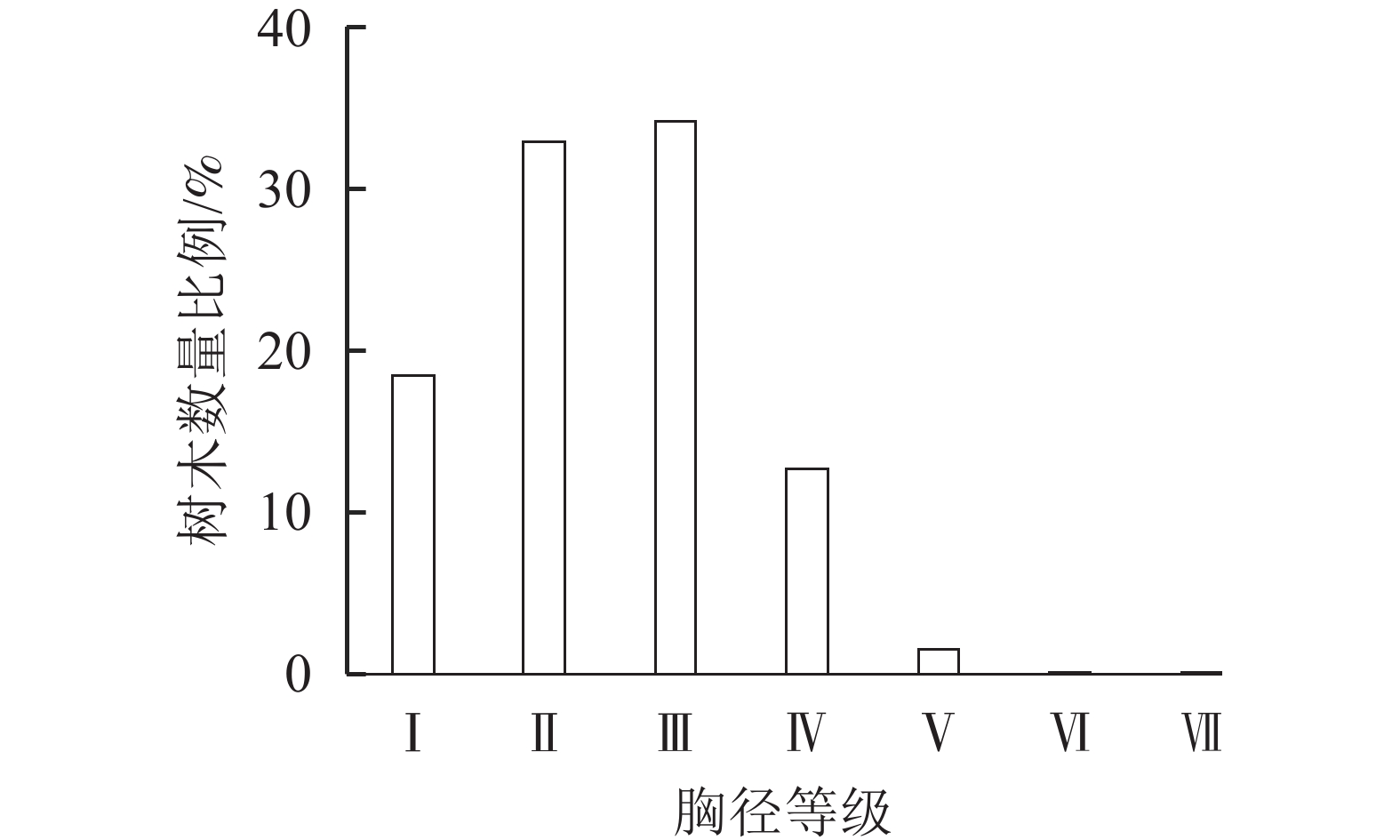
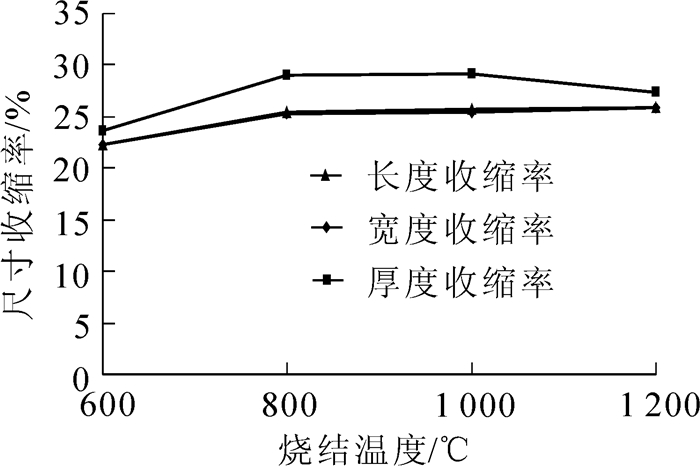
 下载:
下载:


